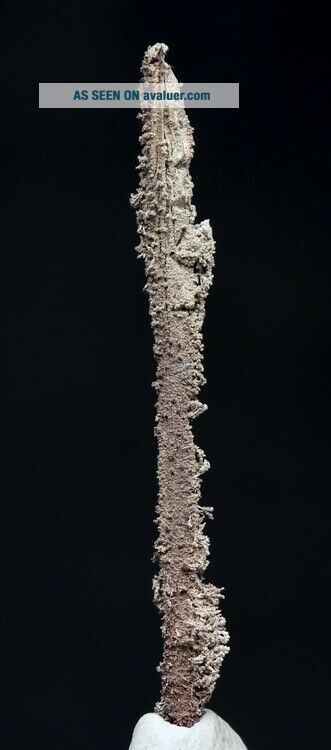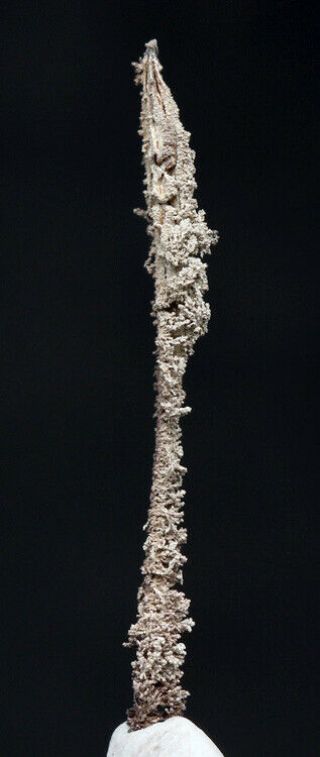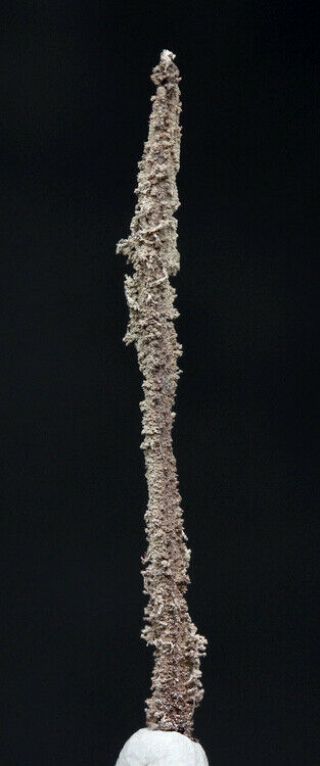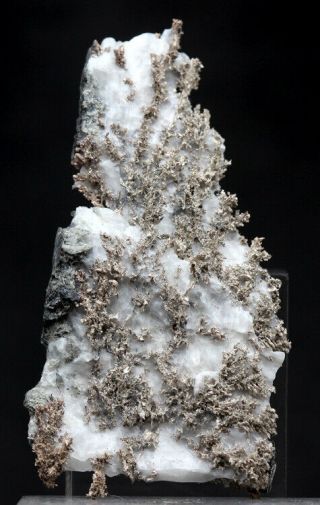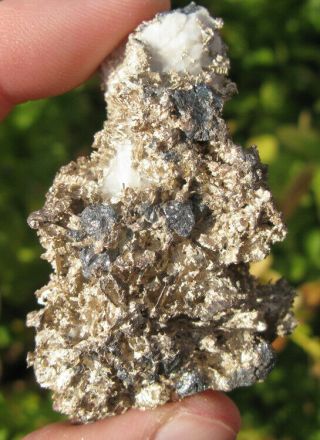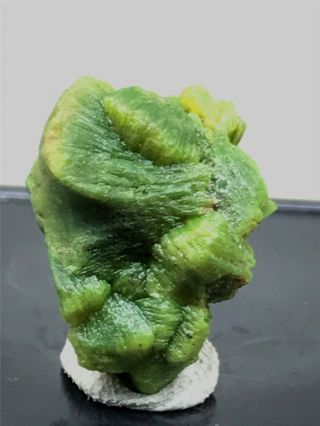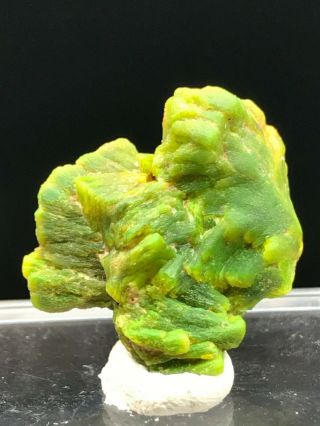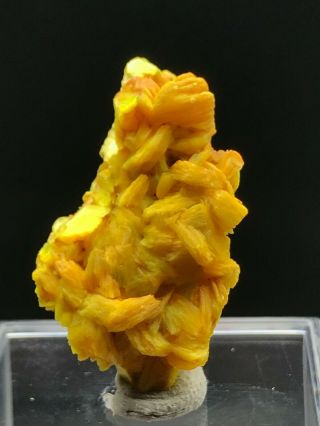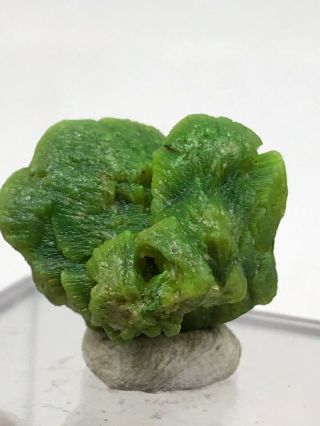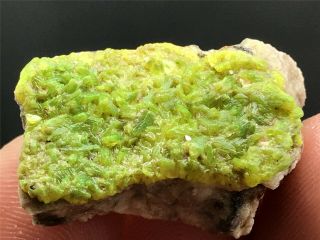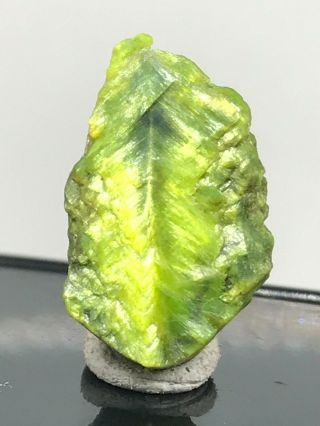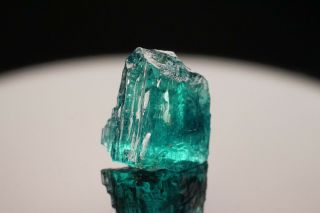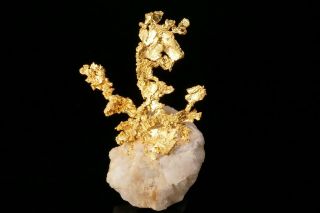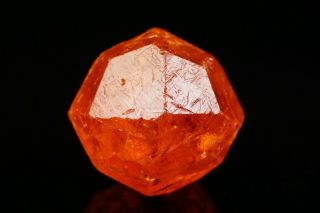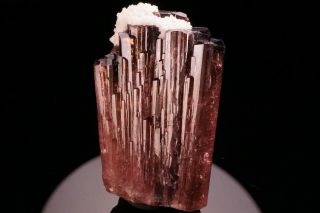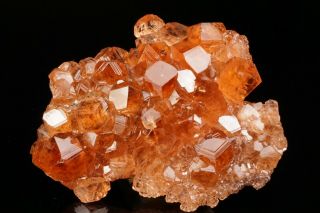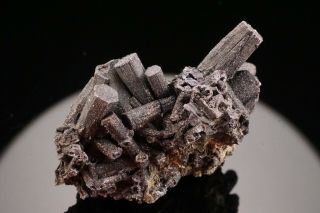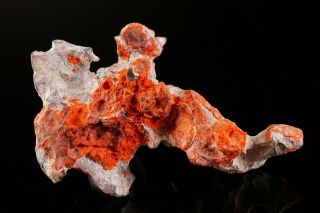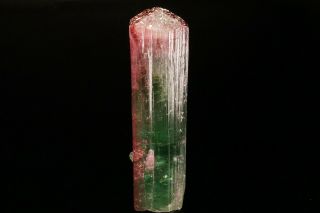RARE NATIVE SILVER Crystal Cluster Natural Mineral Specimen ELURA MINE AUSTRALIA
Item History & Price
| Reference Number: Avaluer:8145623 | Size: 28 mm x 3 mm x 2 mm |
| Mineral: Silver | Weight: 0.23 grams |
I offer a shipping discount for customers who combine their payments for multiple purchases into one payment!
The discount is regular shipping price for the first item and just 50 cents for each additional item!
To be sure you get your shipping discount just make sure all the items you want to purchase are in your cart.
Auctions you win are added to your cart automatically.
For any "buy it now" items or s...econd chance offers, be sure to click the "add to cart" button, NOT the "buy it now" button.
Onceall of your items are in your cart just pay for them from your cart andthe combined shipping discount should be applied automatically.
I offer a money back guarantee on every item I sell.
If you are not 100% happy with your purchase just send me a message to let me know
and I will buy back the item for your full purchase price.
I am selling this 100% natural, native silver specimen. It is absolutely beautiful and it's fascinating to see this precious metal in its natural state! This specimen comes from Elura Mine in New South Wales, Australia. Thanks so much for visiting my Ebay store and have a great day!
Here is some information about this mineral from wikipedia:
SilverFrom Wikipedia, the free encyclopediaJump to navigationJump to searchThis article is about the chemical element. For other uses, see Silver (disambiguation).Silver, 47AgSilver crystal.jpgGeneral propertiesAppearance lustrous white metalStandard atomic weight (Ar, standard) 107.8682(2)[1]Silver in the periodic tableHydrogenHeliumLithiumBerylliumBoronCarbonNitrogenOxygenFluorineNeonSodiumMagnesiumAluminiumSiliconPhosphorusSulfurChlorineArgonPotassiumCalciumScandiumTitaniumVanadiumChromiumManganeseIronCobaltNickelCopperZincGalliumGermaniumArsenicSeleniumBromineKryptonRubidiumStrontiumYttriumZirconiumNiobiumMolybdenumTechnetiumRutheniumRhodiumPalladiumSilverCadmiumIndiumTinAntimonyTelluriumIodineXenonCaesiumBariumLanthanumCeriumPraseodymiumNeodymiumPromethiumSamariumEuropiumGadoliniumTerbiumDysprosiumHolmiumErbiumThuliumYtterbiumLutetiumHafniumTantalumTungstenRheniumOsmiumIridiumPlatinumGoldMercury (element)ThalliumLeadBismuthPoloniumAstatineRadonFranciumRadiumActiniumThoriumProtactiniumUraniumNeptuniumPlutoniumAmericiumCuriumBerkeliumCaliforniumEinsteiniumFermiumMendeleviumNobeliumLawrenciumRutherfordiumDubniumSeaborgiumBohriumHassiumMeitneriumDarmstadtiumRoentgeniumCoperniciumNihoniumFleroviumMoscoviumLivermoriumTennessineOganessonCu↑Ag↓Aupalladium ← silver → cadmiumAtomic number (Z) 47Group group 11Period period 5Element category transition metalBlock d-blockElectron configuration [Kr] 4d10 5s1Electrons per shell2, 8, 18, 18, 1Physical propertiesPhase at STP solidMelting point 1234.93 K (961.78 °C, 1763.2 °F)Boiling point 2435 K (2162 °C, 3924 °F)Density (near r.t.) 10.49 g/cm3when liquid (at m.p.) 9.320 g/cm3Heat of fusion 11.28 kJ/molHeat of vaporisation 254 kJ/molMolar heat capacity 25.350 J/(mol·K)Vapour pressureP (Pa) 1 10 100 1 k 10 k 100 kat T (K) 1283 1413 1575 1782 2055 2433Atomic propertiesOxidation states −2, −1, 1, 2, 3 (an amphoteric oxide)Electronegativity Pauling scale: 1.93Ionisation energies 1st: 731.0 kJ/mol2nd: 2070 kJ/mol3rd: 3361 kJ/molAtomic radius empirical: 144 pmCovalent radius 145±5 pmVan der Waals radius 172 pmColor lines in a spectral rangeSpectral linesOther propertiesCrystal structure face-centred cubic (fcc)Face-centered cubic crystal structure for silverSpeed of sound thin rod 2680 m/s (at r.t.)Thermal expansion 18.9 µm/(m·K) (at 25 °C)Thermal conductivity 429 W/(m·K)Thermal diffusivity 174 mm2/s (at 300 K)Electrical resistivity 15.87 nΩ·m (at 20 °C)Magnetic ordering diamagnetic[2]Magnetic susceptibility −19.5·10−6 cm3/mol (296 K)[3]Young's modulus 83 GPaShear modulus 30 GPaBulk modulus 100 GPaPoisson ratio 0.37Mohs hardness 2.5Vickers hardness 251 MPaBrinell hardness 206–250 MPaCAS Number 7440-22-4HistoryDiscovery before 5000 BCMain isotopes of silverIsotope Abundance Half-life (t1/2) Decay mode Product105Ag syn 41.2 d ε 105Pdγ –106mAg syn 8.28 d ε 106Pdγ –107Ag 51.839% stable108mAg syn 418 y ε 108PdIT 108Agγ –109Ag 48.161% stable111Ag syn 7.45 d β− 111Cdγ –viewtalkedit| references | in WikidataSilver is a chemical element with symbol Ag (from the Latin argentum, derived from the Proto-Indo-European h₂erǵ: "shiny" or "white") and atomic number 47. A soft, white, lustrous transition metal, it exhibits the highest electrical conductivity, thermal conductivity, and reflectivity of any metal. The metal is found in the Earth's crust in the pure, free elemental form ("native silver"), as an alloy with gold and other metals, and in minerals such as argentite and chlorargyrite. Most silver is produced as a byproduct of copper, gold, lead, and zinc refining.
Silver has long been valued as a precious metal. Silver metal is used in many bullion coins, sometimes alongside gold:[4] while it is more abundant than gold, it is much less abundant as a native metal.[5] Its purity is typically measured on a per-mille basis; a 94%-pure alloy is described as "0.940 fine". As one of the seven metals of antiquity, silver has had an enduring role in most human cultures.
Other than in currency and as an investment medium (coins and bullion), [6] silver is used in solar panels, water filtration, jewellery, ornaments, high-value tableware and utensils (hence the term silverware), in electrical contacts and conductors, in specialized mirrors, window coatings, in catalysis of chemical reactions, as a colorant in stained glass and in specialised confectionery. Its compounds are used in photographic and X-ray film. Dilute solutions of silver nitrate and other silver compounds are used as disinfectants and microbiocides (oligodynamic effect), added to bandages and wound-dressings, catheters, and other medical instruments.
Contents1 Characteristics1.1 Isotopes2 Chemistry3 Compounds3.1 Oxides and chalcogenides3.2 Halides3.3 Other inorganic compounds3.4 Coordination compounds3.5 Organometallic3.6 Intermetallic4 Etymology5 History6 Symbolic role7 Occurrence and production8 Monetary use8.1 Price9 Applications9.1 Jewellery and silverware9.2 Medicine9.3 Electronics9.4 Brazing alloys9.5 Chemical equipment9.6 Catalysis9.7 Photography9.8 Nanoparticles9.9 Miscellanea10 Precautions11 See also12 References13 Bibliography14 External linksCharacteristics
Silver is extremely ductile, and can be drawn into a wire one atom wide.[7]Silver is similar in its physical and chemical properties to its two vertical neighbours in group 11 of the periodic table, copper and gold. Its 47 electrons are arranged in the configuration [Kr]4d105s1, similarly to copper ([Ar]3d104s1) and gold ([Xe]4f145d106s1); group 11 is one of the few groups in the d-block which has a completely consistent set of electron configurations.[8] This distinctive electron configuration, with a single electron in the highest occupied s subshell over a filled d subshell, accounts for many of the singular properties of metallic silver.[9]
Silver is an extremely soft, ductile and malleable transition metal, though it is slightly less malleable than gold. Silver crystallizes in a face-centered cubic lattice with bulk coordination number 12, where only the single 5s electron is delocalized, similarly to copper and gold.[10] Unlike metals with incomplete d-shells, metallic bonds in silver are lacking a covalent character and are relatively weak. This observation explains the low hardness and high ductility of single crystals of silver.[11]
Silver has a brilliant white metallic luster that can take a high polish, [12] and which is so characteristic that the name of the metal itself has become a colour name.[9] Unlike copper and gold, the energy required to excite an electron from the filled d band to the s-p conduction band in silver is large enough (around 385 kJ/mol) that it no longer corresponds to absorption in the visible region of the spectrum, but rather in the ultraviolet; hence silver is not a coloured metal.[9] Protected silver has greater optical reflectivity than aluminium at all wavelengths longer than ~450 nm.[13] At wavelengths shorter than 450 nm, silver's reflectivity is inferior to that of aluminium and drops to zero near 310 nm.[14]
Very high electrical and thermal conductivity is common to the elements in group 11, because their single s electron is free and does not interact with the filled d subshell, as such interactions (which occur in the preceding transition metals) lower electron mobility.[15] The electrical conductivity of silver is the greatest of all metals, greater even than copper, but it is not widely used for this property because of the higher cost. An exception is in radio-frequency engineering, particularly at VHF and higher frequencies where silver plating improves electrical conductivity because those currents tend to flow on the surface of conductors rather than through the interior. During World War II in the US, 13540 tons of silver were used in electromagnets for enriching uranium, mainly because of the wartime shortage of copper.[16][17][18] Pure silver has the highest thermal conductivity of any metal, although the conductivity of carbon (in the diamond allotrope) and superfluid helium-4 are even higher.[8] Silver also has the lowest contact resistance of any metal.[8]
Silver readily forms alloys with copper and gold, as well as zinc. Zinc-silver alloys with low zinc concentration may be considered as face-centred cubic solid solutions of zinc in silver, as the structure of the silver is largely unchanged while the electron concentration rises as more zinc is added. Increasing the electron concentration further leads to body-centred cubic (electron concentration 1.5), complex cubic (1.615), and hexagonal close-packed phases (1.75).[10]
IsotopesMain article: Isotopes of silverNaturally occurring silver is composed of two stable isotopes, 107Ag and 109Ag, with 107Ag being slightly more abundant (51.839% natural abundance). This almost equal abundance is rare in the periodic table. The atomic weight is 107.8682(2) u;[19][20] this value is very important because of the importance of silver compounds, particularly halides, in gravimetric analysis.[19] Both isotopes of silver are produced in stars via the s-process (slow neutron capture), as well as in supernovas via the r-process (rapid neutron capture).[21]
Twenty-eight radioisotopes have been characterized, the most stable being 105Ag with a half-life of 41.29 days, 111Ag with a half-life of 7.45 days, and 112Ag with a half-life of 3.13 hours. Silver has numerous nuclear isomers, the most stable being 108mAg (t1/2 = 418 years), 110mAg (t1/2 = 249.79 days) and 106mAg (t1/2 = 8.28 days). All of the remaining radioactive isotopes have half-lives of less than an hour, and the majority of these have half-lives of less than three minutes.[22]
Isotopes of silver range in relative atomic mass from 92.950 u (93Ag) to 129.950 u (130Ag);[23] the primary decay mode before the most abundant stable isotope, 107Ag, is electron capture and the primary mode after is beta decay. The primary decay products before 107Ag are palladium (element 46) isotopes, and the primary products after are cadmium (element 48) isotopes.[22]
The palladium isotope 107Pd decays by beta emission to 107Ag with a half-life of 6.5 million years. Iron meteorites are the only objects with a high-enough palladium-to-silver ratio to yield measurable variations in 107Ag abundance. Radiogenic 107Ag was first discovered in the Santa Clara meteorite in 1978.[24] The discoverers suggest the coalescence and differentiation of iron-cored small planets may have occurred 10 million years after a nucleosynthetic event. 107Pd–107Ag correlations observed in bodies that have clearly been melted since the accretion of the solar system must reflect the presence of unstable nuclides in the early solar system.[25]
ChemistryOxidation states and stereochemistries of silver[26]Oxidation state Coordination number Stereochemistry Representativecompound0 (d10s1) 3 Planar Ag(CO)31 (d10) 2 Linear [Ag(CN)2]−3 Trigonal planar AgI(PEt2Ar)24 Tetrahedral [Ag(diars)2]+6 Octahedral AgF, AgCl, AgBr2 (d9) 4 Square planar [Ag(py)4]2+3 (d8) 4 Square planar [AgF4]−6 Octahedral [AgF6]3−Silver is a rather unreactive metal. This is because its filled 4d shell is not very effective in shielding the electrostatic forces of attraction from the nucleus to the outermost 5s electron, and hence silver is near the bottom of the electrochemical series (E0(Ag+/Ag) = +0.799 V).[9] In group 11, silver has the lowest first ionization energy (showing the instability of the 5s orbital), but has higher second and third ionization energies than copper and gold (showing the stability of the 4d orbitals), so that the chemistry of silver is predominantly that of the +1 oxidation state, reflecting the increasingly limited range of oxidation states along the transition series as the d-orbitals fill and stabilize.[27] Unlike copper, for which the larger hydration energy of Cu2+ as compared to Cu+ is the reason why the former is the more stable in aqueous solution and solids despite lacking the stable filled d-subshell of the latter, with silver this effect is swamped by its larger second ionisation energy. Hence, Ag+ is the stable species in aqueous solution and solids, with Ag2+ being much less stable as it oxidizes water.[27]
Most silver compounds have significant covalent character due to the small size and high first ionization energy (730.8 kJ/mol) of silver.[9] Furthermore, silver's Pauling electronegativity of 1.93 is higher than that of lead (1.87), and its electron affinity of 125.6 kJ/mol is much higher than that of hydrogen (72.8 kJ/mol) and not much less than that of oxygen (141.0 kJ/mol).[28] Due to its full d-subshell, silver in its main +1 oxidation state exhibits relatively few properties of the transition metals proper from groups 4 to 10, forming rather unstable organometallic compounds, forming linear complexes showing very low coordination numbers like 2, and forming an amphoteric oxide[29] as well as Zintl phases like the post-transition metals.[30] Unlike the preceding transition metals, the +1 oxidation state of silver is stable even in the absence of π-acceptor ligands.[27]
Silver does not react with air, even at red heat, and thus was considered by alchemists as a noble metal along with gold. Its reactivity is intermediate between that of copper (which forms copper(I) oxide when heated in air to red heat) and gold. Like copper, silver reacts with sulfur and its compounds; in their presence, silver tarnishes in air to form the black silver sulfide (copper forms the green sulfate instead, while gold does not react). Unlike copper, silver will not react with the halogens, with the exception of fluorine gas, with which it forms the difluoride. While silver is not attacked by non-oxidizing acids, the metal dissolves readily in hot concentrated sulfuric acid, as well as dilute or concentrated nitric acid. In the presence of air, and especially in the presence of hydrogen peroxide, silver dissolves readily in aqueous solutions of cyanide.[26]
The three main forms of deterioration in historical silver artifacts are tarnishing, formation of silver chloride due to long-term immersion in salt water, as well as reaction with nitrate ions or oxygen. Fresh silver chloride is pale yellow, becoming purplish on exposure to light; it projects slightly from the surface of the artifact or coin. The precipitation of copper in ancient silver can be used to date artifacts, as copper is nearly always a constituent of silver alloys.[31]
Silver metal is attacked by strong oxidizers such as potassium permanganate (KMnO4) and potassium dichromate (K2Cr2O7), and in the presence of potassium bromide (KBr). These compounds are used in photography to bleach silver images, converting them to silver bromide that can either be fixed with thiosulfate or redeveloped to intensify the original image. Silver forms cyanide complexes (silver cyanide) that are soluble in water in the presence of an excess of cyanide ions. Silver cyanide solutions are used in electroplating of silver.[32]
The common oxidation states of silver are (in order of commonness): +1 (the most stable state; for example, silver nitrate, AgNO3); +2 (highly oxidising; for example, silver(II) fluoride, AgF2); and even very rarely +3 (extreme oxidising; for example, potassium tetrafluoroargentate(III), KAgF4).[33] The +1 state is by far the most common, followed by the easily reducible +2 state. The +3 state requires very strong oxidising agents to attain, such as fluorine or peroxodisulfate, and some silver(III) compounds react with atmospheric moisture and attack glass.[34] Indeed, silver(III) fluoride is usually obtained by reacting silver or silver monofluoride with the strongest known oxidizing agent, krypton difluoride.[35]
CompoundsOxides and chalcogenides
Silver(I) sulfideSilver and gold have rather low chemical affinities for oxygen, lower than copper, and it is therefore expected that silver oxides are thermally quite unstable. Soluble silver(I) salts precipitate dark-brown silver(I) oxide, Ag2O, upon the addition of alkali. (The hydroxide AgOH exists only in solution; otherwise it spontaneously decomposes to the oxide.) Silver(I) oxide is very easily reduced to metallic silver, and decomposes to silver and oxygen above 160 °C.[36] This and other silver(I) compounds may be oxidized by the strong oxidizing agent peroxodisulfate to black AgO, a mixed silver(I, III) oxide of formula AgIAgIIIO2. Some other mixed oxides with silver in non-integral oxidation states, namely Ag2O3 and Ag3O4, are also known, as is Ag3O which behaves as a metallic conductor.[36]
Silver(I) sulfide, Ag2S, is very readily formed from its constituent elements and is the cause of the black tarnish on some old silver objects. It may also be formed from the reaction of hydrogen sulfide with silver metal or aqueous Ag+ ions. Many non-stoichiometric selenides and tellurides are known; in particular, AgTe~3 is a low-temperature superconductor.[36]
HalidesMain article: Silver halide
The three common silver halide precipitates: from left to right, silver iodide, silver bromide, and silver chloride.The only known dihalide of silver is the difluoride, AgF2, which can be obtained from the elements under heat. A strong yet thermally stable and therefore safe fluorinating agent, silver(II) fluoride is often used to synthesize hydrofluorocarbons.[37]
In stark contrast to this, all four silver(I) halides are known. The fluoride, chloride, and bromide have the sodium chloride structure, but the iodide has three known stable forms at different temperatures; that at room temperature is the cubic zinc blende structure. They can all be obtained by the direct reaction of their respective elements.[37] As the halogen group is descended, the silver halide gains more and more covalent character, solubility decreases, and the color changes from the white chloride to the yellow iodide as the energy required for ligand-metal charge transfer (X−Ag+ → XAg) decreases.[37] The fluoride is anomalous, as the fluoride ion is so small that it has a considerable solvation energy and hence is highly water-soluble and forms di- and tetrahydrates.[37] The other three silver halides are highly insoluble in aqueous solutions and are very commonly used in gravimetric analytical methods.[19] All four are photosensitive (though the monofluoride is so only to ultraviolet light), especially the bromide and iodide which photodecompose to silver metal, and thus were used in traditional photography.[37] The reaction involved is:[38]
X− + hν → X + e− (excitation of the halide ion, which gives up its extra electron into the conduction band)Ag+ + e− → Ag (liberation of a silver ion, which gains an electron to become a silver atom)The process is not reversible because the silver atom liberated is typically found at a crystal defect or an impurity site, so that the electron's energy is lowered enough that it is "trapped".[38]
Other inorganic compounds
Crystals of silver nitrateWhite silver nitrate, AgNO3, is a versatile precursor to many other silver compounds, especially the halides, and is much less sensitive to light. It was once called lunar caustic because silver was called luna by the ancient alchemists, who believed that silver was associated with the moon.[39] It is often used for gravimetric analysis, exploiting the insolubility of the heavier silver halides which it is a common precursor to.[19] Silver nitrate is used in many ways in organic synthesis, e.g. for deprotection and oxidations. Ag+ binds alkenes reversibly, and silver nitrate has been used to separate mixtures of alkenes by selective absorption. The resulting adduct can be decomposed with ammonia to release the free alkene.[40]
Yellow silver carbonate, Ag2CO3 can be easily prepared by reacting aqueous solutions of sodium carbonate with a deficiency of silver nitrate.[41] Its principal use is for the production of silver powder for use in microelectronics. It is reduced with formaldehyde, producing silver free of alkali metals:[42]
Ag2CO3 + CH2O → 2 Ag + 2 CO2 + H2Silver carbonate is also used as a reagent in organic synthesis such as the Koenigs-Knorr reaction. In the Fétizon oxidation, silver carbonate on celite acts as an oxidising agent to form lactones from diols. It is also employed to convert alkyl bromides into alcohols.[41]
Silver fulminate, AgCNO, a powerful, touch-sensitive explosive used in percussion caps, is made by reaction of silver metal with nitric acid in the presence of ethanol. Other dangerously explosive silver compounds are silver azide, AgN3, formed by reaction of silver nitrate with sodium azide, [43] and silver acetylide, Ag2C2, formed when silver reacts with acetylene gas in ammonia solution.[27] In its most characteristic reaction, silver azide decomposes explosively, releasing nitrogen gas: given the photosensitivity of silver salts, this behaviour may be induced by shining a light on its crystals.[27]
2 AgN3 (s) → 3 N2 (g) + 2 Ag (s)Coordination compounds
Structure of the diamminesilver(I) complex, [Ag(NH3)2]+Silver complexes tend to be similar to those of its lighter homologue copper. Silver(III) complexes tend to be rare and very easily reduced to the more stable lower oxidation states, though they are slightly more stable than those of copper(III). For instance, the square planar periodate [Ag(IO5OH)2]5− and tellurate [Ag{TeO4(OH)2}2]5− complexes may be prepared by oxidising silver(I) with alkaline peroxodisulfate. The yellow diamagnetic [AgF4]− is much less stable, fuming in moist air and reacting with glass.[34]
Silver(II) complexes are more common. Like the valence isoelectronic copper(II) complexes, they are usually square planar and paramagnetic, which is increased by the greater field splitting for 4d electrons than for 3d electrons. Aqueous Ag2+, produced by oxidation of Ag+ by ozone, is a very strong oxidising agent, even in acidic solutions: it is stabilized in phosphoric acid due to complex formation. Peroxodisulfate oxidation is generally necessary to give the more stable complexes with heterocyclic amines, such as [Ag(py)4]2+ and [Ag(bipy)2]2+: these are stable provided the counterion cannot reduce the silver back to the +1 oxidation state. [AgF4]2− is also known in its violet barium salt, as are some silver(II) complexes with N- or O-donor ligands such as pyridine carboxylates.[44]
By far the most important oxidation state for silver in complexes is +1. The Ag+ cation is diamagnetic, like its homologues Cu+ and Au+, as all three have closed-shell electron configurations with no unpaired electrons: its complexes are colourless provided the ligands are not too easily polarized such as I−. Ag+ forms salts with most anions, but it is reluctant to coordinate to oxygen and thus most of these salts are insoluble in water: the exceptions are the nitrate, perchlorate, and fluoride. The tetracoordinate tetrahedral aqueous ion [Ag(H2O)4]+ is known, but the characteristic geometry for the Ag+ cation is 2-coordinate linear. For example, silver chloride dissolves readily in excess aqueous ammonia to form [Ag(NH3)2]+; silver salts are dissolved in photography due to the formation of the thiosulfate complex [Ag(S2O3)2]3−; and cyanide extraction for silver (and gold) works by the formation of the complex [Ag(CN)2]−. Silver cyanide forms the linear polymer {Ag–C≡N→Ag–C≡N→}; silver thiocyanate has a similar structure, but forms a zigzag instead because of the sp3-hybridized sulfur atom. Chelating ligands are unable to form linear complexes and thus silver(I) complexes with them tend to form polymers; a few exceptions exist, such as the near-tetrahedral diphosphine and diarsine complexes [Ag(L–L)2]+.[45]
OrganometallicMain article: Organosilver chemistryUnder standard conditions, silver does not form simple carbonyls, due to the weakness of the Ag–C bond. A few are known at very low temperatures around 6–15 K, such as the green, planar paramagnetic Ag(CO)3, which dimerizes at 25–30 K, probably by forming Ag–Ag bonds. Additionally, the silver carbonyl [Ag(CO)] [B(OTeF5)4] is known. Polymeric AgLX complexes with alkenes and alkynes are known, but their bonds are thermodynamically weaker than even those of the platinum complexes (though they are formed more readily than those of the analogous gold complexes): they are also quite unsymmetrical, showing the weak π bonding in group 11. Ag–C σ bonds may also be formed by silver(I), like copper(I) and gold(I), but the simple alkyls and aryls of silver(I) are even less stable than those of copper(I) (which tend to explode under ambient conditions). For example, poor thermal stability is reflected in the relative decomposition temperatures of AgMe (−50 °C) and CuMe (−15 °C) as well as those of PhAg (74 °C) and PhCu (100 °C).[46]
The C–Ag bond is stabilized by perfluoroalkyl ligands, for example in AgCF(CF3)2.[47] Alkenylsilver compounds are also more stable than their alkylsilver counterparts.[48] Silver-NHC complexes are easily prepared, and are commonly used to prepare other NHC complexes by displacing labile ligands. For example, the reaction of the bis(NHC)silver(I) complex with bis(acetonitrile)palladium dichloride or chlorido(dimethyl sulfide)gold(I):[49]
Silver-NHC as carbene transmetallation agent.pngIntermetallic
Different colors of silver–copper–gold alloysSilver forms alloys with most other elements on the periodic table. The elements from groups 1–3, except for hydrogen, lithium, and beryllium, are very miscible with silver in the condensed phase and form intermetallic compounds; those from groups 4–9 are only poorly miscible; the elements in groups 10–14 (except boron and carbon) have very complex Ag–M phase diagrams and form the most commercially important alloys; and the remaining elements on the periodic table have no consistency in their Ag–M phase diagrams. By far the most important such alloys are those with copper: most silver used for coinage and jewellery is in reality a silver–copper alloy, and the eutectic mixture is used in vacuum brazing. The two metals are completely miscible as liquids but not as solids; their importance in industry comes from the fact that their properties tend to be suitable over a wide range of variation in silver and copper concentration, although most useful alloys tend to be richer in silver than the eutectic mixture (71.9% silver and 28.1% copper by weight, and 60.1% silver and 28.1% copper by atom).[50]
Most other binary alloys are of little use: for example, silver–gold alloys are too soft and silver–cadmium alloys too toxic. Ternary alloys have much greater importance: dental amalgams are usually silver–tin–mercury alloys, silver–copper–gold alloys are very important in jewellery (usually on the gold-rich side) and have a vast range of hardnesses and colours, silver–copper–zinc alloys are useful as low-melting brazing alloys, and silver–cadmium–indium (involving three adjacent elements on the periodic table) is useful in nuclear reactors because of its high thermal neutron capture cross-section, good conduction of heat, mechanical stability, and resistance to corrosion in hot water.[50]
EtymologyThe word "silver" appears in Anglo-Saxon in various spellings, such as seolfor and siolfor. A similar form is seen throughout the Germanic languages (compare Old High German silabar and silbir). The chemical symbol Ag is from the Latin word for "silver", argentum (compare Ancient Greek ἄργυρος, árgyros), from the Proto-Indo-European root *h₂erǵ- (formerly reconstructed as *arǵ-), meaning "white" or "shining": this was the usual Proto-Indo-European word for the metal, whose reflexes are missing in Germanic and Balto-Slavic. The Balto-Slavic words for silver are quite similar to the Germanic ones (e.g. Russian серебро [serebro], Polish srebro, Lithuanian sidabras) and they may have a common origin, although this is uncertain: some scholars have suggested the Akkadian sarpu "refined silver" as this origin, related to the word sarapu "to refine or smelt".[51][52]
History
Silver plate from the 4th centurySilver was one of the seven metals of antiquity that were known to prehistoric humans and whose discovery is thus lost to history.[53] In particular, the three metals of group 11, copper, silver, and gold, occur in the elemental form in nature and were probably used as the first primitive forms of money as opposed to simple bartering.[54] However, unlike copper, silver did not lead to the growth of metallurgy on account of its low structural strength, and was more often used ornamentally or as money.[55] Since silver is more reactive than gold, supplies of native silver were much more limited than those of gold.[54] For example, silver was more expensive than gold in Egypt until around the fifteenth century BC:[56] the Egyptians are thought to have separated gold from silver by heating the metals with salt, and then reducing the silver chloride produced to the metal.[57]
The situation changed with the discovery of cupellation, a technique that allowed silver metal to be extracted from its ores. While slag heaps found in Asia Minor and on the islands of the Aegean Sea indicate that silver was being separated from lead as early as the 4th millennium BC, [8] and one of the earliest silver extraction centres in Europe was Sardinia in early the Chalcolithic period, [58] these techniques did not spread widely until later, when it spread throughout the region and beyond.[56] The origins of silver production in India, China, and Japan were almost certainly equally ancient, but are not well-documented due to their great age.[57]
Silver mining and processing in Kutná Hora, Bohemia, 1490sWhen the Phoenicians first came to what is now Spain, they obtained so much silver that they could not fit it all on their ships, and as a result used silver to weight their anchors instead of lead.[56] By the time of the Greek and Roman civilizations, silver coins were a staple of the economy:[54] the Greeks were already extracting silver from galena by the 7th century BC, [56] and the rise of Athens was partly made possible by the nearby silver mines at Laurium, from which they extracted about 30 tonnes a year from 600 to 300 BC.[59] The stability of the Roman currency relied to a high degree on the supply of silver bullion, mostly from Spain, which Roman miners produced on a scale unparalleled before the discovery of the New World. Reaching a peak production of 200 tonnes per year, an estimated silver stock of 10000 tonnes circulated in the Roman economy in the middle of the second century AD, five to ten times larger than the combined amount of silver available to medieval Europe and the Abbasid Caliphate around AD 800.[60][61] The Romans also recorded the extraction of silver in central and northern Europe in the same time period. This production came to a nearly complete halt with the fall of the Roman Empire, not to resume until the time of Charlemagne: by then, tens of thousands of tonnes of silver had already been extracted.[57]
Central Europe became the centre of silver production during the Middle Ages, as the Mediterranean deposits exploited by the ancient civilisations had been exhausted. Silver mines were opened in Bohemia, Saxony, Erzgebirge, Alsace, the Lahn region, Siegerland, Silesia, Hungary, Norway, Steiermark, Salzburg, and the southern Black Forest. Most of these ores were quite rich in silver and could simply be separated by hand from the remaining rock and then smelted; some deposits of native silver were also encountered. Many of these mines were soon exhausted, but a few of them remained active until the Industrial Revolution, before which the world production of silver was around a meagre 50 tonnes per year.[57] In the Americas, high temperature silver-lead cupellation technology was developed by pre-Inca civilizations as early as AD 60–120; silver deposits in India, China, Japan, and pre-Columbian America continued to be mined during this time.[57][62]
With the discovery of America and the plundering of silver by the Spanish conquistadors, Central and South America became the dominant producers of silver until around the beginning of the 18th century, particularly Peru, Bolivia, Chile, and Argentina:[57] the last of these countries later took its name from that of the metal that composed so much of its mineral wealth.[59] The silver trade this was a part of gave way to a global network of exchange. As one historian put it, silver "went round the world and made the world go round."[63] Much of this silver ended up in the hands of the Chinese. A Portuguese merchant in 1621 noted that silver "wanders throughout all the world... before flocking to China, where it remains as if at its natural center."[64] Still, much of it went to Spain, allowing Spanish rulers to pursue military and political ambitions in both Europe and the Americas. "New World mines, " concluded several historians, "supported the Spanish empire."[65]
In the 19th century, primary production of silver moved to North America, particularly Canada, Mexico, and Nevada in the United States: some secondary production from lead and zinc ores also took place in Europe, and deposits in Siberia and the Russian Far East as well as in Australia were mined.[57] Poland emerged as an important producer during the 1970s after the discovery of copper deposits that were rich in silver, before the centre of production returned to the Americas the following decade. Today, Peru and Mexico are still among the primary silver producers, but the distribution of silver production around the world is quite balanced and about one-fifth of the silver supply comes from recycling instead of new production.[57]
Symbolic role
16th-century fresco painting of Judas being paid thirty pieces of silver for his betrayal of JesusSilver plays a certain role in mythology and has found various usage as a metaphor and in folklore. The Greek poet Hesiod's Works and Days (lines 109–201) lists different ages of man named after metals like gold, silver, bronze and iron to account for successive ages of humanity.[66] Ovid's Metamorphoses contains another retelling of the story, containing an illustration of silver's metaphorical use of signifying the second-best in a series, better than bronze but worse than gold:
But when good Saturn, banish'd from above, Was driv'n to Hell, the world was under Jove.Succeeding times a silver age behold, Excelling brass, but more excell'd by gold.
— Ovid, Metamorphoses, Book I, trans. John DrydenIn folklore, silver was commonly thought to have mystic powers: for example, a bullet cast from silver is often supposed in such folklore the only weapon that is effective against a werewolf, witch, or other monsters.[67][68] From this the idiom of a silver bullet developed into figuratively referring to any simple solution with very high effectiveness or almost miraculous results, as in the widely discussed software engineering paper No Silver Bullet.[69]
Silver production has also inspired figurative language. Clear references to cupellation occur throughout the Old Testament of the Bible, such as in Jeremiah's rebuke to Judah: "The bellows are burned, the lead is consumed of the fire; the founder melteth in vain: for the wicked are not plucked away. Reprobate silver shall men call them, because the Lord hath rejected them." (Jeremiah 6:19–20) Jeremiah was also aware of sheet silver, exemplifying the malleability and ductility of the metal: "Silver spread into plates is brought from Tarshish, and gold from Uphaz, the work of the workman, and of the hands of the founder: blue and purple is their clothing: they are all the work of cunning men." (Jeremiah 10:9)[56]
Silver also has more negative cultural meanings: the idiom thirty pieces of silver, referring to a reward for betrayal, references the bribe Judas Iscariot is said in the New Testament to have taken from Jewish leaders in Jerusalem to turn Jesus of Nazareth over to soldiers of the high priest Caiaphas.[70] Ethically, silver also symbolizes greed and degradation of consciousness; this is the negative aspect, the perverting of its value.[71]
Occurrence and productionFurther information: Silver mining
Acanthite sample from the Chispas Mine in Sonora, Mexico; scale at bottom of image as one inch with a rule at one centimetreThe abundance of silver in the Earth's crust is 0.08 parts per million, almost exactly the same as that of mercury. It mostly occurs in sulfide ores, especially acanthite and argentite, Ag2S. Argentite deposits sometimes also contain native silver when they occur in reducing environments, and when in contact with salt water they are converted to chlorargyrite (including horn silver), AgCl, which is prevalent in Chile and New South Wales.[72] Most other silver minerals are silver pnictides or chalcogenides; they are generally lustrous semiconductors. Most true silver deposits, as opposed to argentiferous deposits of other metals, came from Tertiary period vulcanism.[73]
The principal sources of silver are the ores of copper, copper-nickel, lead, and lead-zinc obtained from Peru, Bolivia, Mexico, China, Australia, Chile, Poland and Serbia.[8] Peru, Bolivia and Mexico have been mining silver since 1546, and are still major world producers. Top silver-producing mines are Cannington (Australia), Fresnillo (Mexico), San Cristóbal (Bolivia), Antamina (Peru), Rudna (Poland), and Penasquito (Mexico).[74] Top near-term mine development projects through 2015 are Pascua Lama (Chile), Navidad (Argentina), Jaunicipio (Mexico), Malku Khota (Bolivia), [75] and Hackett River (Canada).[74] In Central Asia, Tajikistan is known to have some of the largest silver deposits in the world.[76]
Silver is usually found in nature combined with other metals, or in minerals that contain silver compounds, generally in the form of sulfides such as galena (lead sulfide) or cerussite (lead carbonate). So the primary production of silver requires the smelting and then cupellation of argentiferous lead ores, a historically important process.[77] Lead melts at 327 °C, lead oxide at 888 °C and silver melts at 960 °C. To separate the silver, the alloy is melted again at the high temperature of 960 °C to 1000 °C in an oxidizing environment. The lead oxidises to lead monoxide, then known as litharge, which captures the oxygen from the other metals present. The liquid lead oxide is removed or absorbed by capillary action into the hearth linings.[78][79][80]
Ag(s) + 2Pb(s) + O2(g) → 2PbO(absorbed) + Ag(l)Today, silver metal is primarily produced instead as a secondary byproduct of electrolytic refining of copper, lead, and zinc, and by application of the Parkes process on lead bullion from ore that also contains silver.[81] In such processes, silver follows the non-ferrous metal in question through its concentration and smelting, and is later purified out. For example, in copper production, purified copper is electrolytically deposited on the cathode, while the less reactive precious metals such as silver and gold collect under the anode as the so-called "anode slime". This is then separated and purified of base metals by treatment with hot aerated dilute sulfuric acid and heating with lime or silica flux, before the silver is purified to over 99.9% purity via electrolysis in nitrate solution.[72]
Commercial-grade fine silver is at least 99.9% pure, and purities greater than 99.999% are available. In 2014, Mexico was the top producer of silver (5, 000 tonnes or 18.7% of the world's total of 26, 800 t), followed by China (4, 060 t) and Peru (3, 780 t).[81]
Monetary use
1, 000 oz silver barThe earliest known coins were minted in the kingdom of Lydia in Asia Minor around 600 BC.[82] The coins of Lydia were made of electrum, which is a naturally occurring alloy of gold and silver, that was available within the territory of Lydia.[82] Since that time, silver standards, in which the standard economic unit of account is a fixed weight of silver, have been widespread throughout the world until the 20th century. Notable silver coins through the centuries include the Greek drachma, [83] the Roman denarius, [84] the Islamic dirham, [85] the Indian rupee from the time of the Mughal Empire (grouped with copper and gold coins to create a trimetallic standard), [86] and the Spanish dollar.[87][88]
The ratio between the amount of silver used for coinage and that used for other purposes has fluctuated greatly over time; for example, in wartime, more silver tends to have been used for coinage to finance the war.[89]
Today, silver bullion has the ISO 4217 currency code XAG, one of only four precious metals to have one (the others being palladium, platinum, and gold).[90] Silver coins are produced from cast rods or ingots, rolled to the correct thickness, heat-treated, and then used to cut blanks from. These blanks are then milled and minted in a coining press; modern coining presses can produce 8000 silver coins per hour.[89]
PriceAs of July 2018, silver is valued at around $495 per kilogram, or about $15.5 per ounce.[91]
Silver prices are normally quoted in Troy ounces. One troy ounce is equal to 31.1034 grams. In 2015 China reverted to the metric system and currently prices silver (and gold) in grams.[92][93] The London silver fix is published once daily at noon London time. This price is determined by several major international banks and is used by London bullion market members for trading that day. Prices are most commonly shown as the United States dollar (USD), the Pound sterling (GBP), and the Euro (EUR).
ApplicationsJewellery and silverware
Silver toilet set of Alexandra NikolaevnaThe major use of silver besides coinage throughout most of history was in the manufacture of jewellery and other general-use items, and this continues to be a major use today. Examples include table silver for cutlery, for which silver is highly suited due to its antibacterial properties. Western concert flutes are usually plated with or made out of sterling silver;[94] in fact, most silverware is only silver-plated rather than made out of pure silver; the silver is normally put in place by electroplating. Silver-plated glass (as opposed to metal) is used for mirrors, vacuum flasks, and Christmas tree decorations.[95]
Because pure silver is very soft, most silver used for these purposes is alloyed with copper, with finenesses of 925/1000, 835/1000, and 800/1000 being common. One drawback is the easy tarnishing of silver in the presence of hydrogen sulfide and its derivatives. Including precious metals such as palladium, platinum, and gold gives resistance to tarnishing but is quite costly; base metals like zinc, cadmium, silicon, and germanium do not totally prevent corrosion and tend to affect the lustre and colour of the alloy. Electrolytically refined pure silver plating is effective at increasing resistance to tarnishing. The usual solutions for restoring the lustre of tarnished silver are dipping baths that reduce the silver sulfide surface to metallic silver, and cleaning off the layer of tarnish with a paste; the latter approach also has the welcome side effect of polishing the silver concurrently.[94] A simple chemical approach to removal of the sulfide tarnish is to bring silver items into contact with aluminium foil whilst immersed in water containing a conducting salt, such as sodium chloride.[citation needed]
MedicineMain article: Medical uses of silverIn medicine, silver is incorporated into wound dressings and used as an antibiotic coating in medical devices. Wound dressings containing silver sulfadiazine or silver nanomaterials are used to treat external infections. Silver is also used in some medical applications, such as urinary catheters (where tentative evidence indicates it reduces catheter-related urinary tract infections) and in endotracheal breathing tubes (where evidence suggests it reduces ventilator-associated pneumonia).[96][97] The silver ion is bioactive and in sufficient concentration readily kills bacteria in vitro. They interfere with enzymes in the bacteria that transport nutrients, form structures, synthesise cell walls, and bond with the bacteria's genetic material. Microbes cannot develop resistance to silver as they can to antibiotics, and hence silver and silver nanoparticles are used as an antimicrobial in a variety of industrial, healthcare, and domestic application: for example, infusing clothing with nanosilver particles thus allows them to stay odourless for longer.[98][99] Silver compounds are taken up by the body like mercury compounds, but lack the toxicity of the latter. Silver and its alloys are used in cranial surgery to replace bone, and silver–tin–mercury amalgams are used in dentistry.[95] Silver diammine fluoride, the fluoride salt of a coordination complex with the formula [Ag(NH3)2]F, is a topical medicament (drug) used to treat and prevent dental caries (cavities) and relieve dentinal hypersensitivity.[100]
ElectronicsSilver is very important in electronics for conductors and electrodes on account of its high electrical conductivity even when tarnished. Bulk silver and silver foils were used to make vacuum tubes, and continue to be used today in the manufacture of semiconductor devices, circuits, and their components. For example, silver is used in high quality connectors for RF, VHF, and higher frequencies, particularly in tuned circuits such as cavity filters where conductors cannot be scaled by more than 6%. Printed circuits and RFID antennas are made with silver paints, [8][101] Powdered silver and its alloys are used in paste preparations for conductor layers and electrodes, ceramic capacitors, and other ceramic components.[102]
Brazing alloysSilver-containing brazing alloys are used for brazing metallic materials, mostly cobalt, nickel, and copper-based alloys, tool steels, and precious metals. The basic components are silver and copper, with other elements selected according to the specific application desired: examples include zinc, tin, cadmium, palladium, manganese, and phosphorus. Silver provides increased workability and corrosion resistance during usage.[103]
Chemical equipmentSilver is useful in the manufacture of chemical equipment on account of its low chemical reactivity, high thermal conductivity, and being easily workable. Silver crucibles (alloyed with 0.15% nickel to avoid recrystallisation of the metal at red heat) are used for carrying out alkaline fusion. Copper and silver are also used when doing chemistry with fluorine. Equipment made to work at high temperatures is often silver-plated. Silver and its alloys with gold are used as wire or ring seals for oxygen compressors and vacuum equipment.[104]
CatalysisSilver metal is a good catalyst for oxidation reactions; in fact it is somewhat too good for most purposes, as finely divided silver tends to result in complete oxidation of organic substances to carbon dioxide and water, and hence coarser-grained silver tends to be used instead. For instance, 15% silver supported on α-Al2O3 or silicates is a catalyst for the oxidation of ethylene to ethylene oxide at 230–270 °C. Dehydrogenation of methanol to formaldehyde is conducted at 600–720 °C over silver gauze or crystals as the catalyst, as is dehydrogenation of isopropanol to acetone. In the gas phase, glycol yields glyoxal and ethanol yields acetaldehyde, while organic amines are dehydrated to nitriles.[104]
PhotographyThe photosensitivity of the silver halides allowed for their use in traditional photography, although digital photography, which does not use silver, is now dominant. The photosensitive emulsion used in black-and-white photography is a suspension of silver halide crystals in gelatin, possibly mixed in with some noble metal compounds for improved photosensitivity, developing, and tuning. Colour photography requires the addition of special dye components and sensitisers, so that the initial black-and-white silver image couples with a different dye component. The original silver images are bleached off and the silver is then recovered and recycled. Silver nitrate is the starting material in all cases.[105]
The use of silver nitrate and silver halides in photography has rapidly declined with the advent of digital technology. From the peak global demand for photographic silver in 1999 (267, 000, 000 troy ounces or 8304.6 metric tonnes) the market contracted almost 70% by 2013.[106]
NanoparticlesMain article: Silver nanoparticleNanosilver particles, between 10 and 100 nanometres in size, are used in many applications. They are used in conductive inks for printed electronics, and have a much lower melting point than larger silver particles of micrometre size. They are also used medicinally in antibacterials and antifungals in much the same way as larger silver particles.[99]
Miscellanea
A tray of South Asian sweets, with some pieces covered with shiny silver varkPure silver metal is used as a food colouring. It has the E174 designation and is approved in the European Union.[107] Traditional Pakistani and Indian dishes sometimes include decorative silver foil known as vark, [108] and in various other cultures, silver dragée are used to decorate cakes, cookies, and other dessert items.[109]
Photochromic lenses include silver halides, so that ultraviolet light in natural daylight liberates metallic silver, darkening the lenses. The silver halides are reformed in lower light intensities. Colourless silver chloride films are used in radiation detectors. Zeolite sieves incorporating Ag+ ions are used to desalinate seawater during rescues, using silver ions to precipitate chloride as silver chloride. Silver is also used for its antibacterial properties for water sanitisation, but the application of this is limited by limits on silver consumption. Colloidal silver is similarly used to disinfect closed swimming pools; while it has the advantage of not giving off a smell like hypochlorite treatments do, colloidal silver is not effective enough for more contaminated open swimming pools. Small silver iodide crystals are used in cloud seeding to cause rain.[99]
00305



